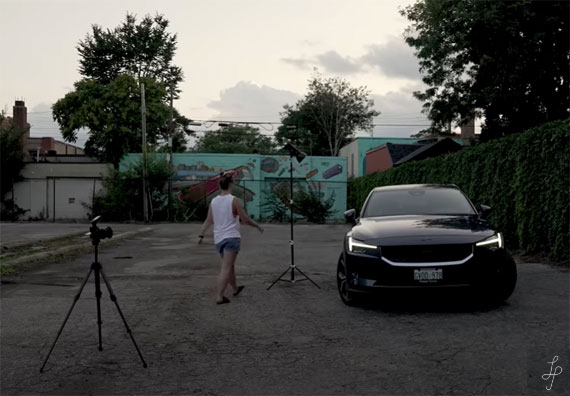Professional photographer Lizzie Peirce hails from Toronto, Canada. She’s photographed for some of the top car brands, including Toyota and Mercedez Benz. So, she knows a thing or two about getting the perfect shot of luxury sports cars! However, her process extends much further than photography — all the way down to post-production and editing. In this video, she shares her top tips on how to shoot and edit images of cars using strobe lights.
Get Your Camera Set Up Right
For this shoot, Lizzie chose her Sony A7 and Sony 24mm F1.4 GM lens, both of which remain stationary on a tripod throughout. For natural light settings, she’s set the aperture to F/7.1 in order to capture even more of the cars’ detailing. She uses a shutter speed of 1/50 sec as the camera and lens will be securely resting on the tripod. Lizzie also suggests you secure the camera at around the height of the car mirror.
Lastly, she recommends ISO 100 up to 200, but this depends on your lighting. Now that the camera is all set up, you’ll need to sort out your strobe light settings. In Lizzie’s case, the ideal setting is 1800, but just like ISO settings, this figure could vary for you. For this shoot, Lizzie shot both in full natural light and low light — the latter of which she recommends as the strobe really “shines” in these conditions.
Leverage Your Strobe Light
What I want to make sure I capture is definitely an angle with the strobe … what you’re trying to do is capture it (the area of the car) in the most attractive way…
The main aim of shooting with strobe lights is to shoot detailing, which is what makes these lights excellent for photographing vehicles. Each car comprises tons of small, interesting elements, from grilles to rims and even the curves of the hood and car body. To achieve this, Lizzie shoots multiple strobe photos from various angles, highlighting a select area each time. However, she captures a full photo of the car first without any strobe, which she’ll use as a base to build upon later.
Once this initial shot is captured, she starts strobing, moving the light to each area of the car methodically. At this point, you should make sure that the strobe light doesn’t obscure the camera’s view of the specific area of the car you’re trying to capture. Otherwise, you’ll need to somehow edit the strobe light out or may even have to discard the image entirely. You also want to ensure that the car is clean. Touching up any unwanted dust or grime later on can take up a lot of time.
Editing Is Everything
As you can see, photographing cars with strobe lights doesn’t result in one photo but many. Extensive editing is required to end up with a single finalized image. Lizzie’s go-to for lighting effects is Adobe Lightroom. She uses it to edit the base photo first, applying the same setting across all the other strobe images afterward. Her next step is to export the images to their own folder on her PC, compressing each image to 5000 KB.
Photoshop is where she puts it all together. Here’s a summarized guide on how to go about editing strobe car photos into one stunning image:
- First, drag all the images you wish to use into one Photoshop file and rasterize them.
- Then, auto-align the images by selecting Edit > Auto-Align Layers.. > Auto. Even though her camera barely moved, she warns to always align images as there are often small variations.
- Now it’s time to put all the images together. Start with the base image, which you should label “Base Image” or similar to make it easy to find.
- The editing process mainly focuses on masking parts of the base layer to reveal the best strobed image overlays. To do so, select one of the strobed images, add a mask, then select the paintbrush tool (hardness to 0).
- Next, invert the mask (ctrl I) to black. Now you can easily “paint” to reveal the strobed image or flip back to white to unpaint unwanted pixels. Do this for all of the strobed images.
- Last, repair any “hotspots” created by the flash — Lizzie makes a new layer on top of all others first. Then, restores any lost details that have been erased due to flash light or strobe hotspots.
Conclusion
Every subject demands a unique approach to photography, including the occasional use of strobe lights. Lizzie’s process is one she’s developed from extensive experiences photographing cars. She’s not shy to use strobe lights or editing software to get that perfect shot — and neither should you. Strobe lights can really bring out the best in vehicles, even in natural light settings.
Like This Article?
Don't Miss The Next One!
Join over 100,000 photographers of all experience levels who receive our free photography tips and articles to stay current:






